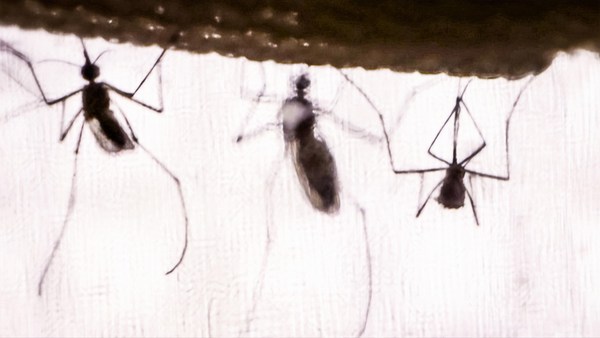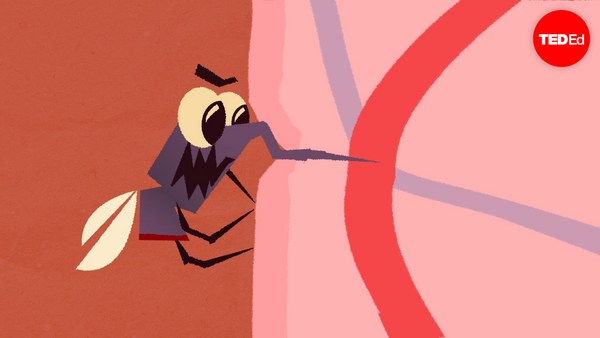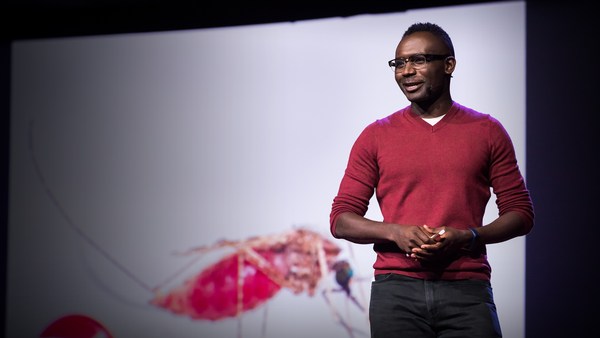We're going to have hotter, drier summers in our cities. We're going to have to deal with more frequent and intense heat waves. It's going to have an impact on our health and well-being, but not just us. What about the plants and animals that call our cities home? So what could we do about that? We could green our cities, we could plant trees. The shade provided by trees provides protection from those impacts of the heat. But what do we need to make those plants thrive and survive? We need water. Our green cities need water, but mosquitoes also like water. And so how can we balance the impacts that come from both of those, if we perhaps are inadvertently creating increasing pests and public health risks for ourselves in the ways in which we try to respond to a changing climate? How can we green our cities and not create a problem with mosquitoes?
The mosquito is the deadliest animal on the planet. About half a million people die every year because of mosquito bite. Diseases such as malaria and dengue infect hundreds of millions of people every year, across the planet. That burden of disease weighs quite heavily on both communities and local authorities, as they struggle to try to deal with those impacts. Here in Australia, we're very fortunate to be free of some of the more serious mosquito-borne diseases, but there are still pathogens spread by local mosquitoes that can make us sick. So something like Ross River virus. If we get infected with this virus, we may not die, but we could get seriously ill. Fever, rash, joint pain, fatigue ... We could be battling illness for many months. But notwithstanding the burden of disease, what about the nuisance that mosquitoes can have just to our day-to-day lives? How many of you have been bothered by mosquitoes when you're outside, enjoying the barbecue or visiting the local wetlands during summer? What about that mosquito that buzzes around your bedroom at night? How can we manage these risks and move forward, and try to live in a greener city and not create opportunities for mosquitoes?
So I spend my summers sloshing about in wetlands, wrangling mosquitoes. Despite the sunburn and the mosquito bites and the mud, I actually do quite like my job. And I've also got a confession to make to you all ... I actually quite like mosquitoes.
(Laughter)
I'm quite fascinated by them. I think they're actually quite beautiful, if you get a chance to look at them underneath the microscope. So before I started my research and first looked through a microscope at a mosquito, I don't think I'd really given them much of a thought. I knew that they were involved in outbreaks of disease overseas, and I was quite familiar with that smell of a smoldering mosquito coil. It still reminds me of summer holidays. But the work I do now, together with that of scientists around the country, is trying to work out how we can stop people getting sick because of mosquito bites. It requires us to understand the role that mosquitoes have in our local environment, and how we can change our cities so that we're greening our cities, we're mitigating those impacts of climate change, but at the same time not creating opportunities for mosquitoes.
Did you know there are over 60 different types of mosquitoes that are found in Western Sydney? So it's not just that one mosquito that you slap on your arm and squash; they're an incredibly diverse and interesting range of animals. There's 60 different types across Western Sydney. These mosquitoes might be big, they might be small. They might be black with distinctively striped legs. They might be a pale brown color. Or they might be a really vibrant orange color. But one of the things I love about all of these mosquitoes is that they're very unique, they've adapted to very different types of environment. It’s one of the reasons that I like them, because they’re incredibly adaptive. But it’s also the thing that worries me about them, because they could be adapting to these sources of water we're creating around our cities.
So mosquitoes are found in an incredibly wide range of environments, from coastal rock pools to snowmelt streams in our Alpine regions, from polluted drains to pristine wetlands and almost every puddle of water in between. There are mosquitoes found in all of these environments. And understanding how the mosquitoes interact with these environments and the climate is really important to understand how they might play a role in outbreaks of disease. But all of these mosquitoes essentially need two things: they need blood and they need water. So I'll get to the blood in a little while, but let me talk to you about why water is really important for mosquitoes.
The humble mossie is a really frail and fragile creature. Looks like it'll fall apart in a strong breeze. It's hard to imagine these are the most dangerous animals on the planet. But these animals kind of rely on water; they've got an amazing life cycle that starts in the water. They need water. So eggs are laid in and around sources of water, and then, when it rains, or tides come into the wetlands, these eggs hatch, and out of these eggs hatch these wormlike larvae that swim around in the water. Maybe you’ve seen them in puddles or your pot plant saucers. Or maybe, as I did as a child, if you're a bit slow to clean your backyard swimming pool when warmer weather arrives, all of a sudden, you can see these mosquitoes swimming around at the top of the water. But during summer, it might only take a week or so for them to emerge from that water and start flying around. They only live for a few weeks, but during that time, they can bite a lot of people, and they can lay more than a thousand eggs.
But to get those eggs, they need blood. Mosquitoes need blood, that's why they bite. It's only the female mosquito that bites, and she needs that protein hit in her blood to develop her eggs. They can live quite happily on plant juices and sugars, most of the time, but they really need that blood to develop eggs. And the animals they can get that blood from can be incredibly varied, from cows and kangaroos to birds to frogs. But also us. And I know some of us in this room, you're probably thinking, "Boy, mosquitoes sure like to bite me more than they like to bite my friends." And sometimes, we can be a bit unlucky like that. But it's also important to remember that mosquitoes, when they bite, can not only create an itchy red lump on our skin, but they can also make us sick. They can transmit pathogens that make us sick. But mosquitoes aren’t flying around, transferring droplets of infected blood from person to person. These are not dirty syringes; they’re much more complicated organisms. So the mosquitoes themselves have to become infected with the pathogen before they can pass that on to us. And when it comes to pathogen transmission, not all mosquitoes are created equal. It's why it's really important to understand mosquitoes, because even though we have dozens of mosquitoes here in Sydney that could transmit something like Ross River virus, there are no mosquitoes currently in Sydney that can transmit the pathogens that cause more serious diseases, things like dengue, chikungunya or Zika. Let's hope it stays that way.
So what does a green city look like for a mosquito? So first of all, there are trees that provide shade, protection from wind and sun ... It provides these kind of protected, humid little areas, where mosquitoes can take refuge. The longer mosquitoes live, the more people they bite, the more eggs they lay. But it’s not so much the plants but the water they need, which is really critical for mosquitoes. So in a green city, we have water tanks, we build wetlands. We’ve got green walls and frog ponds. We’ve got bioretention basins. We’ve got rain gardens. All of these structures that might be designed to store and recycle water in and around our cities and suburbs could be used by mosquitoes. Remember, mosquitoes love this water that's available to them. So how can we design our cities so that mosquitoes aren't quick to adapt to these types of environments? Wherever there's water, mosquitoes will lay eggs, and we have to be mindful about that as we try to respond and green our cities, create the structures that will help us. It'll make a city greater. I want to live in a green city. I would love to live in a green city; it's probably great for my physical and mental health and well-being. I just don't want to share that with too many mosquitoes. And mosquitoes are so adaptive that I'm sure that they're going to create opportunities in these structures that we're building, and so I'm really worried that we're going to see more and more mosquitoes into the future.
So how do you create a wetland that's not home to mosquitoes? One of the really interesting pieces of research we've found in recent years is that problematic mosquito populations often seem to be associated with wetlands of poor health: wetlands that have more stagnant water, wetlands that don't have enough predators to eat the mosquitoes. So it’s a tantalizing idea that if you can create a wetland that's healthier, it has more water flow, it has a greater level of biodiversity, you can actually keep mosquito populations down. If you provide habitats for the animals that eat mosquitoes -- the birds, the bats, the fish, the frogs, the spiders, any number of aquatic insects that love munching on mosquitoes -- rather than being a problem, mosquitoes are not going to disappear, we're not going to get rid of mosquitoes completely, but if they're at a more balanced place in the ecosystem, maybe we'll have fewer pest impacts, and more importantly, maybe we will see less mosquito-borne disease.
But what about stormwater drains? These are already a common sight in our local wetlands, and there's a mosquito that calls these habitats home, which you all already know. You may not notice it when it flies past you, but you know its sound. You've probably learned to hate the sound of this mosquito, more so than its bite. This is a mosquito called the brown house mosquito. It loves breeding in polluted ponds and pipes and waterways; it's going to be quick to exploit the ways in which we store wastewater in our cities. The thing is about this mosquito is that it loves coming indoors at night. It's the mosquito that's going to be buzzing around your face at night, keep you awake, disrupting your sleep. Now the reason you can hear that mosquito is not because it makes a sound that's different to any other mosquito. It's just that a mosquito prefers to bite birds, and so it's flying around your face and your body, responding to your heat and the smell of your skin, working out, "Is this a large, featherless bird? I'm not sure whether I want to bite it or not." It's bad luck for those of you who smell a bit like a bird.
(Laughter)
But it's a reminder that sometimes, it's not just the bite of mosquitoes that's the problem, it's the disturbance that can be caused by large numbers of mosquitoes. And so we don't want these mosquitoes coming inside our homes, where we're kind of creating opportunities for these mosquitoes in our cities.
So what about our backyards? We all want to keep our backyards healthy, we want to have a great opportunity for our plants and our pets and the local wildlife. One effective way to do that is installing a rainwater tank. Problem is, rainwater tanks can be a great source for very serious mosquitoes. You all in this room have probably been bitten by the Australian backyard mosquito. Its scientific name is Aedes notoscriptus. It is the most widespread mosquito in Australia; almost everybody has opportunities for this mosquito in their backyard. Whether it's a birdbath, a pot plant saucer, even the smallest volumes of water trapped in a water-holding container will be a place this mosquito can lay its eggs. It's a nuisance biting pest, but it's not a serious threat to our health. But there's a problem here, because these same habitats where this mosquito is found could also be the home of a mosquito that's associated with the transmission of much more serious pathogens, pathogens that can cause outbreaks of disease such as dengue, chikungunya and Zika. These mosquitoes are the Asian tiger mosquito or the yellow fever mosquito. These two mosquitoes are not found in Sydney at the moment, but worldwide, they contribute to major outbreaks of mosquito-borne disease. They don't breed in wetlands, they love these water-holding containers in our backyards. And as we do a better job of creating these opportunities like rainwater tanks in our backyards, maybe we're creating an opportunity for these mosquitoes to move in.
The yellow fever mosquito, Aedes aegypti, was actually once common in Sydney, but during the '50s, it disappeared. One of the reasons for its disappearance could well have been the fact that we moved away from rainwater tanks. And now, rainwater tanks are coming back. They're going to become more common. And could that see the return of these mosquitoes? I certainly hope not.
So what can authorities do about reducing the mosquitoes associated with these greening cities that we're dealing with? There's a role for our local authorities to consider mosquitoes when they're building wetlands, creating wastewater recycling schemes, regulating the installation of rainwater tanks. Because these are dynamic systems. It's not just about how you design them and build them, but it's how you maintain them. You can't just build them and walk away, because as we've learned, if these habitats degrade, they become more suitable for mosquitoes. These types of structures, these wetlands in our cities, they're great. They help reduce pollution, they help store water, but we don't want them to become an opportunity for mosquitoes.
But what about us? There's a role for local government, for our local authorities, but how an we help protect our families and our friends from the impact of mosquitoes associated with a greening city? I'm going to leave you with three tips that can help you stop the bite of mosquitoes and the buzz of mosquitoes this summer. First of all, don't create opportunities for mosquitoes in your backyard. Anything that traps water after rainfall will be a source of mosquitoes, so tip out, cover up or remove these water-holding containers in your backyard. Screen your rainwater tanks. Clean your gutters and your drains, reduce that standing water that mosquitoes love so much around our homes.
Secondly, insect repellents are a safe and effective way to avoid mosquito bites. When you're choosing a formulation from the local pharmacy or the supermarket, make sure you apply it as a nice, even coat over all exposed areas of skin. Don't put it on like perfume. A dab here or there is not going to provide protection. Unless you've got complete cover, those mosquitoes will find a way to find that gap in your repellent and bite.
Lastly, a way that you might be able to stop the buzz of mosquitoes. Why not just switching on a fan? We know that operating a fan in a bedroom can help reduce those mosquitoes that come in and buzz around our ears at night. It disperses the smells and the temperatures around that body that attracts them; it might make it a bit harder for that mossie to fly around and find us as well.
So finally, I want to leave you with a thought. We may hate mosquitoes, and I understand. I don’t want to convert you into loving these bloodsuckers. But we need to understand them. Because if we can’t understand the diversity of mosquitoes and their relationships with the environments we’re creating in our green cities, it's going to become a much greater struggle to kind of reduce the burden of disease that might come with them. And unfortunately, mosquitoes are going to be yet another challenge we face as we move forward into our future cities under the impact of a changing climate.





